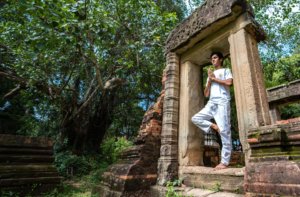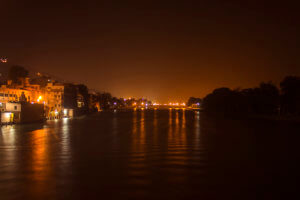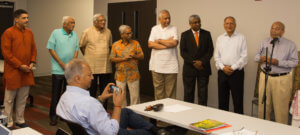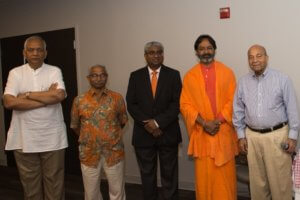It is now approaching two full centuries since the world-view of India has been framed from the Western European colonizers’ perspective. Driven largely from a self-congratulatory rationalization of horrific conquest across the world, the surprise to much of the public is that the narrative was driven through academia, notably that of 19th century Germany’s intellectuals of largely Protestant theological background, with plenty of diverse supporting actors who had overlapping motivations. How do we overcome this self-sustaining and lucrative castle of lies, now perpetuated even by native academics and journalists, who have long been deracinated out of their own culture?

The challenge to western academia
It has been a full 30 years since India opened up out of Nehruvian socialism, “liberalized” its economy, and has seen a full generation accrue varied benefits, of being lifted levels above their largely poor or middle-class socio-economic struggles, while many have remained behind. We have seen many European and Asian countries rebound much quicker than India since World War II, so better techniques and policy options remain to be explored.
This “opening” has extended into the academic and journalistic spheres too, albeit at a slower rate. These challenges to the India narrative have contributed to the emergence of intellectuals in waves; we are merely carrying on, building further, establishing media and academic foundations. From the works of B. B. Lal, Ram Swarup and Sita Ram Goel, to several others that are still active including Meenakshi Jain; in this decade we are live witnesses to the pioneering efforts of Vishwa Adluri, Joydeep Bagchee and others. The social media space today naturally includes noise, but also has many quietly active and diligent researchers working with their own efforts and funds. While the work ahead is monumental, there is reason to be optimistic.
Rare but always present have been the challenges within academic circles, and this is where the researchers, the intellectuals, and the philosophers at institutions like HUA are faced with a critical responsibility to march on. Decades ago, it would have been a dream, but now it is a reality; the ability to engage and produce rigorous scholarly rebuttals, using the language of Indology, is ongoing, with plenty of conscientious western thinkers, such as Nicholas Kazanas, Michel Danino, and several others also joining to provide an India-centric rebuttal. It is our work to ensure that these are disseminated wider, not simply to those preferring the numbness of transient enjoyment in existence, but to the tide who understand the nature of righteous duty.
But what about the common people?
Like many in the last two generations, I, too, have been a beneficiary of a reviving India. What used to be an impossible dream, except for the few who managed to exit India with high qualifications and access, is now turning into a reality for many more. I have had work and travel opportunities that have taken me across Europe and North America, and have seen the “better life”, “the dream”; yet it is rootedness in India that is one of my accomplishments, despite a mild “lactification” (to use Fanon’s term).
It is not just the battles with false-indoctrinated “South Asian” bureau chiefs and academics, but also the commonality of existence in our more innocent encounters with today’s peoples of European descent, who are as human and curious and open as we are, when we are. In modern times, it is a relief to experience less of the jarring racialized and prejudiced interactions of the past, to the warmth and welcome, the curiosity to engage (not just to explore) more of India’s philosophical and visibly impressive offerings. And beyond that, the simplicity, a genuine normality of engagement.
No civilization should simply claim greatness for itself alone; all peoples across time and eternity have brought forth beautiful contributions and developments that override the unresolved horrors. With India, it is indeed a unique place: its visible lack of full recovery from inflicted brutalities have not masked its ancient philosophy, teachings, nor has it hidden what today’s India continues to offer. In my countless interactions, in Russia, the Baltics, and the Balkans, all the way to the western shores with many stops across Africa and Asia, human decency, mutual respect and genuine curiosity remains very much alive.
For these people, unaware of the required narrative change, and the overdue paradigm shifts that may take another generation or two, just engagement with the right values is always one of the steps. It is said that Dharma protects those who protect it, and it sees the world not for conquest, but as family. We are lucky indeed to be associated with these teachings of our ancestors, and commendable are those who live it, with visible benefits to others they meet. The consciousness, the humanity, among peoples of European descent, has never died, and that is a source of comfort and hope.
For among the people far removed from the corridors of power, it is the lived life, doing the right thing, even heroic acts and long-standing contributions, these are among the aims. The strength of family and community, the inner journey to self-discovery, all are done in their own way; it is with some gratitude that an Indian can say our Rishis and Gurus across millennia have left the world a great value system that reinforces the good, and refreshes itself with time. Sanatana.
A higher consciousness
Cruel and invented theories of race, of being, of conquest, the dark side, are never able to fully extinguish the pillars of higher consciousness. In the past, it may have been the more base-minded, the more criminal, the ignorant, and even the innocent that might have fallen for these ideas of superiority borne out of expansionist theologies and ideologies. Seeing poverty or simply different and unusual behavior in the previously colonized nations may have only reinforced those beliefs in some of the less conscientious or even innocent. The encounters would be with people who were hesitant, unsure, attempting to please or just trying to stay safe; the generations of our parents and grandparents, leave alone their forefathers, faced visible ignominies, and often bore it meekly, as habit.
What the common people (of the former colonizing nations) rarely encountered was pushback from a confident, humane and well-wishing non-Western native. The more well-intentioned European thinkers of the past were to be swallowed by the dominant narrative of being the ‘chosen people’, and would have been wise to not challenge it. However, there is a difference now; the critical mass of fellow humans of non-European descent, who can assert their true self without harm, is slowly and continually rising, albeit with additional complications. The morals of the victimizers, never fully extinguished, has compelled them to also look for answers, in themselves and through a search that has taken them far away from their homelands.
This is the opportunity for this generation to continue to build, to not stay silent, to not seek a quarrelsome connectedness. It must retain a spiritual connection while wielding a pen in this endeavor to reset the narrative. This must be continually attempted, even as opposing forces double down with newer and more malicious methods. There is hope. Let the truth prevail, for it is Satya that remains the unyielding pillar in the future paradigm.










